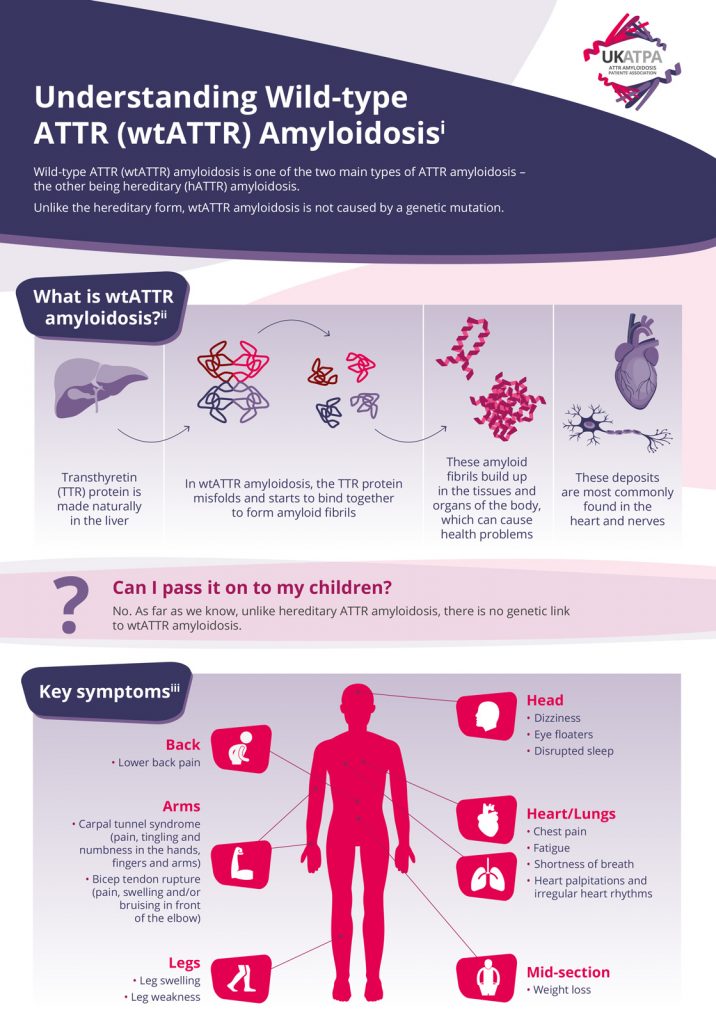Wild-type amyloidosis is a slow-progressing condition that tends to develop later in life – from about the age of 60 or so (although symptoms may occur earlier than this).
It is caused when a protein called TTR becomes unstable and breaks into pieces. When this happens, some of the pieces of that protein clump together. This forms something called fibrils which then eventually bind to create a deposit called amyloid.
If amyloid builds up in organs or body tissue it can cause serious health problems. For example, if it deposits in the heart, this can cause heart disease – sometimes referred to as cardiac disease or cardiomyopathy.
The name ‘wild-type’ refers to the fact that it is the natural (wild) TTR protein that becomes abnormal. In contrast, in hereditary amyloidosis, the ‘faulty’ TTR protein is actually the result of a gene in your body’s DNA being altered – sometimes also referred to as a gene mutation.

Wild-type amyloidosis
Wild-type amyloidosis is a slow-progressing condition that tends to develop later in life – from about the age of 60 or so (although symptoms may occur earlier than this).
It is caused when a protein called TTR becomes unstable and breaks into pieces. When this happens, some of the pieces of that protein clump together. This forms something called fibrils which then eventually bind to create a deposit called amyloid.
If amyloid builds up in organs or body tissue it can cause serious health problems. For example, if it deposits in the heart, this can cause heart disease – sometimes referred to as cardiac disease or cardiomyopathy.
The name ‘wild-type’ refers to the fact that it is the natural (wild) TTR protein that becomes abnormal. In contrast, in hereditary amyloidosis, the ‘faulty’ TTR protein is actually the result of a gene in your body’s DNA being altered – sometimes also referred to as a gene mutation.



What are the symptoms?
Wild-type amyloidosis typically affects people aged over 60 and is more common in men than in women.
Around 25% of patients aged over 80 who have wild-type amyloidosis do not display any symptoms.
Some people who have very small amyloid deposits display minimal symptoms and may not require any treatment at all.
However, some symptoms to be aware of include heart problems.
Typically, symptoms are usually the result of the amyloid deposits stiffening the heart wall, making it difficult for it to pump blood around the body properly. This results in symptoms such as chest pain, shortness of breath and heart palpitations.
Common symptoms to be aware of include:
- Heart palpitations and abnormal heart rhythms
- Shortness of breath
- Chest pain (angina)
- Dizziness
- Eye floaters
- Disrupted sleep
- Fatigue
- Leg swelling (also called oedema)
- Weight loss
- Spinal stenosis (a narrowed spinal cord)
- Bicep tendon rupture
- Heart failure
Tingling, numb hands and fingers
Around 50% of patients with wild-type ATTR amyloidosis experience carpal tunnel syndrome, where there is pain, tingling and numbness in the hands, fingers and arms. This often appears 3-5 years before heart-related symptoms.



What are the symptoms?
Wild-type amyloidosis typically affects people aged over 60 and is more common in men than in women.
Around 25% of patients aged over 80 who have wild-type amyloidosis do not display any symptoms.
Some people who have very small amyloid deposits display minimal symptoms and may not require any treatment at all.
However, some symptoms to be aware of include heart problems.
Typically, symptoms are usually the result of the amyloid deposits stiffening the heart wall, making it difficult for it to pump blood around the body properly. This results in symptoms such as chest pain, shortness of breath and heart palpitations.
Common symptoms to be aware of include:
- Heart palpitations and abnormal heart rhythms
- Shortness of breath
- Chest pain (angina)
- Dizziness
- Eye floaters
- Disrupted sleep
- Fatigue
- Leg swelling (also called oedema)
- Weight loss
- Spinal stenosis (a narrowed spinal cord)
- Bicep tendon rupture
- Heart failure
Tingling, numb hands and fingers
Around 50% of patients with wild-type ATTR amyloidosis experience carpal tunnel syndrome, where there is pain, tingling and numbness in the hands, fingers and arms. This often appears 3-5 years before heart-related symptoms.



How common is wild-type amyloidosis?
Recent developments in testing and medical imaging have greatly improved the detection of amyloid – particularly in the heart.
More cases are now being spotted and this has led scientists to believe that wild-type ATTR amyloidosis may be far more common than was previously thought.
When it is suspected that ATTR amyloidosis may be the cause of amyloid deposits, patients are usually sent to the National Amyloidosis Centre (NAC) for testing.
If you wish to read more about wild-type amyloidosis we recommend visiting the NAC website or the NHS page on amyloidosis. If you think you may have amyloidosis you should always speak to your doctor.
Template materials to take to your GP are available in the Resources section of this website.
How common is wild-type amyloidosis?
Recent developments in testing and medical imaging have greatly improved the detection of amyloid – particularly in the heart.
More cases are now being spotted and this has led scientists to believe that wild-type ATTR amyloidosis may be far more common than was previously thought.
When it is suspected that ATTR amyloidosis may be the cause of amyloid deposits, patients are usually sent to the National Amyloidosis Centre (NAC) for testing.
If you wish to read more about wild-type amyloidosis we recommend visiting the NAC website or the NHS page on amyloidosis. If you think you may have amyloidosis you should always speak to your doctor.
Template materials to take to your GP are available in the Resources section of this website.

